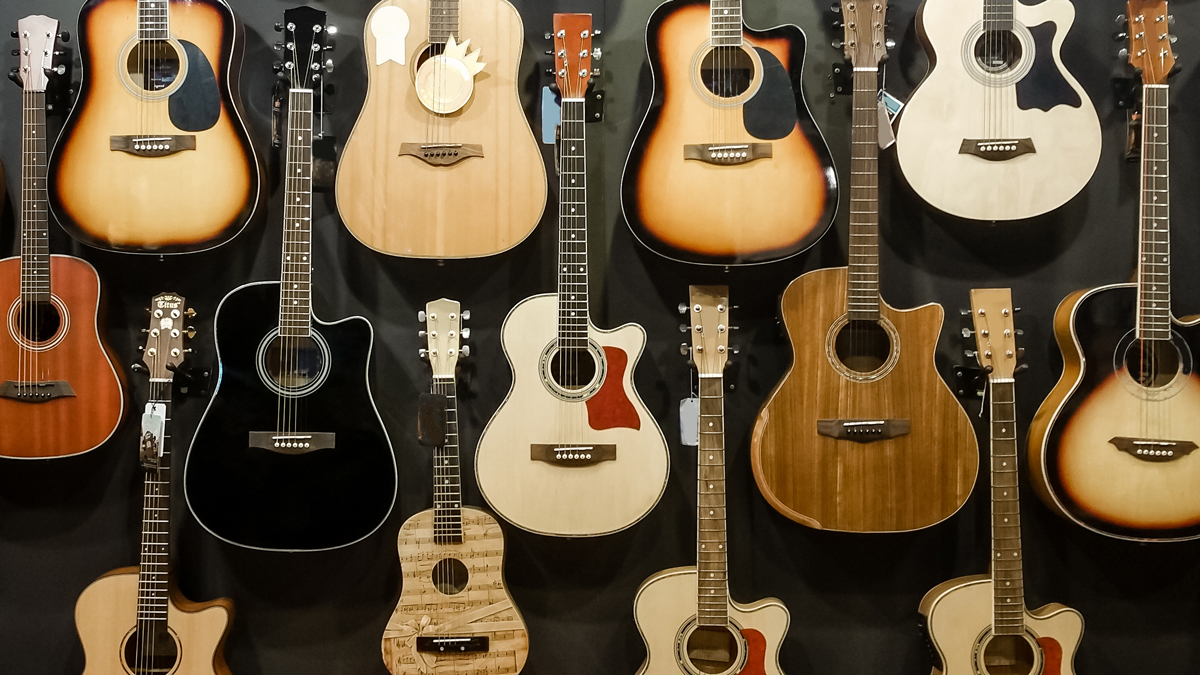
If you are familiar with cars, you know that there are numerous types of them out there. SUVs, Crossovers, Sedans, Hatchbacks, and many more. Well, guitars have that variety too. Admittedly, to a layman, the difference between two guitars may not pop out instantly. To someone with a trained eye though, a musician/guitarist, the difference is as obvious as day and night. Some guitars are more common than others, of course.
So, in this article, I will try my best to inform you guys about “Types of Guitar Every Guitarist Should Know”. Here we go:
Types of Guitar
1. Acoustic Guitars:
When most people picture a guitar, the acoustic guitar is what pops into the mind of the majority. Rightly so, the acoustic guitar is one of the most popular musical instruments out there and, don’t quote me on this, but arguably the most popular. You can find the sub-categories of acoustic guitars listed here, but the overall concept stays the same: A wooden hollow body with 6 steel strings.
Acoustic guitars come in many different shapes and sizes. There is the classic, 6 string acoustic guitar. There is also a 12-string guitar. All the strings are doubled on it to provide a harp-like song. In the acoustic rendition of Wish You Were Here by Pink Floyd, they used a 12-string.
There are many different body shapes acoustic guitars come in, The larger ones are the Jumbo and Dreadnought. These are loud and big as you would expect. For a quieter experience with more articulated tones, you can opt for the Parlor or Auditorium guitars. For kids and adults that are a bit on the shorter side, you can get acoustic guitars in many different sizes. There is the “Full-size”, “Half-size” and “Quarter-Size” which will suit you, you really have to give it a shot IRL to figure that out. You can also shop for acoustic guitar pedals to go with your acoustic set.
2. Electric Guitars:
The electric guitar is an absolute legend! I mean, who here hasn’t seen one in real life or in pictures? Nothing looks cooler than a guitarist ripping out a sick solo or heavy riff on their electric guitar. Even though I mostly play a classical guitar, I got into playing the guitar because of how cool an electric looked. These guitars come in many different shapes and sizes. If you are a fan of Hendrix, he is known for playing the Fender Stratocaster. Alongside the Stratocaster, guitars by Les Paul and Telecaster are legendary.
Electric guitars have a ton of variety. Unfortunately, I am a bit on a word count limit but just to name some examples, there are 7-8-12 strings electric guitars, there are double-neck guitars (Jimmy Page is known for playing those) and many more.
3. Classical Guitars:
Despite the fact that technically speaking, classical guitars come under the category of “acoustic guitars”, we will discuss that below, I consider them to be their own thing. You might disagree and that is completely fine. These guitars are also referred to as Nylon String Guitars or Spanish Guitars.
The reason why they are called Spanish Guitars by some is that every flamenco player played one of these and flamenco is a style of playing guitar that is deeply rooted in the culture of Spain. The origins and roots of Flamenco are shrouded in mystery but most experts agree that it came from Roma migration from Rajasthan, India to Spain between the 9th and 14th centuries. These guitars have Nylon strings instead of steel strings and have an hourglass shape to them. They are the precursors to modern acoustic and electric guitars.
4. Electro-Acoustic Guitars:
Performing on stage with a mic in front of your acoustic guitar gets a bit challenging. It not only restricts your movement but the microphone picks up a ton of noise. So, they installed a small pick-up on an acoustic guitar with a microphone inside. This way, guitarists can plug in their guitars (like you do in an electric) and connect them to an amplifier or PA system. Basically, acoustic guitars with the ability to connect with an amp because of their inbuilt pickup are called electric acoustic guitars.
5. Semi-Acoustic Guitars:
Also known as Hollow Body Guitars, these offer a middle-ground between the electric and acoustic guitar. They have the tone of an acoustic guitar but with the flip of a switch, you can achieve the tones of an electric guitar as well. This style of guitar is very popular amongst blues and jazz players but also those guitarists that want a single guitar that does a lot. These get a bad rep sometimes because they can’t sound as good as a fully electric/acoustic guitar. Well, of course, they can’t. They have their own charm.
The above was 5 “Types of Guitar Every Guitarist Should Know”. Thank you for reading!




